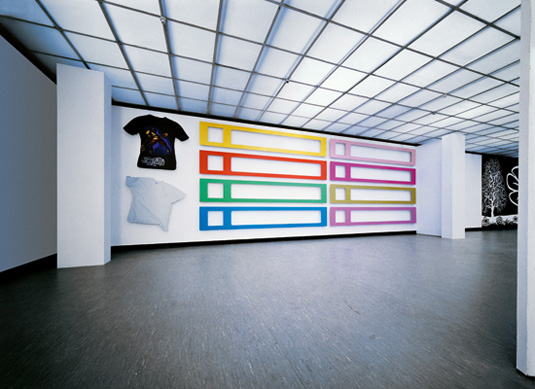| Michel Majerus |
|
 Ralf Christofori Michel Majerus – Hohe Kunst und Pop TrashThe work of Michel Majerus remains unfinished. Born in 1967, he studied at the Stuttgart State Academy of Art and Design before moving his life and his work to Berlin. Only ten years later, he died in an airplane crash near his hometown of Luxemburg. When the Landesbank Baden-Württemberg merged its collection of contemporary German art in 1999 and showed it at several exhibition spaces in Stuttgart, Majerus was one of the youngest artists exhibited. He was then 32 years old. Shown were several of his quadratic canvas works – studies in acrylics in medium-format, swiftly painted and so “fleeing oblivion”[1], which almost recklessly confront wild abstraction with color-field painting, trash with trance, the iconic with the comic. These untitled works, each alone and all together, fitted marvelously well into the ambience of the collection: they understood themselves splendidly with the works of Majerus’s Berlin companions Tobias Rehberger and Franz Ackermann, and tied in confidently with the those of Martin Kippenberger and Albert Oehlen, who may be safely called Majerus’s mentors. And if the viewer followed the majuscule inscription “A LINK TO THE PAST” on one of the canvases, and the profusion of artistic and motivic references diffused throughout the works, he inevitably came to Sigmar Polke, Willem de Kooning, Andy Warhol and other international stars. No matter whether this artistic attitude of Majerus’s is interpreted as an embrace or monopolization, retrospection appears to confirm the substantial truth of the observation. Hardly a work of his stands alone for itself. They all attempt to come to grips with other works. And not only with works of other artists, but also and precisely with Majerus’s own work. Majerus exhibited the quadratic canvasses already mentioned for the first time in 1996 in a one-man show at the Berlin art gallery Neugerriemschneider, where they occupied a whole wall in a pattern of five times six works. The exhibition bore the equally cautious and insistent title fertiggestellt zur zufriedenheit aller, die bedenken haben [completed to the satisfaction of everyone who has misgivings]. The misgivings that Majerus could have meant originate in a time when the so-called “theory of the post-modern” threatened, then as now, to devour its own children under cover of the fig leaf of pluralism. Thus, for example, Arthur C. Danto wrote disapprovingly that an artist could now “be an abstract painter in the morning, a photo-realist in the afternoon, and a minimal minimalist in the evening. [...] The age of pluralism is here. It no longer matters what one does – that is what pluralism means”.[2] Danto’s diagnosis, however, takes no account of the fact that the pluralism of styles and expressive forms is only the proven means to the end of a deeper coming to terms with painting and the picture – as, for instance, in Majerus’s work. The mastery of diverse painterly qualities and motivic appropriations was not for him an end in itself, as Günther Holler-Schuster has stressed. Rather, Majerus appropriated as a painter “cultural codes” that were, for their part, already conveyed by the employed media: “Not the subjective sentiment is the decisive element in the process of production, but rather the analysis of the cultural production of artifacts. Not the reference to reality in the traditional sense is at the center of artistic endeavors, but rather the reference to the communicated media”.[3] [...] [1] Vgl. Raimar Stange, „Michel Majerus”, in: Landesbank Baden-Württemberg (Hg.), ZOOM. Ansichten zur deutschen Gegenwartskunst, Sammlung Landesbank Baden-Württemberg, Stuttgart, Hatje Cantz, Ostfildern-Ruit, 1999, S. 374. [2] Arthur C. Danto, Die Philosophische Entmündigung der Kunst, Fink, München, 1993, S. 144. [3] Günther Holler-Schuster, “Von hier aus können wir überall hingehen. Michel Majerus und die Erweiterung der Malerei”, in: Peter Pakesch (ed.), What looks good today, may not look good tomorrow. Michel Majerus. Installationen 92-02, exhibit. cat. Kunsthaus Graz am Landesmuseum Joanneum, Verlag der Buchhandlung Walther König, Cologne, 2005, p. 172. Catalog excerpt "Extended. Sammlung Landesbank Baden-Württemberg" Editors: Lutz Casper, Gregor Jansen, published by Kehrer Verlag Heidelberg, 2009 ^
|
